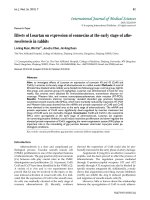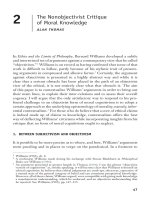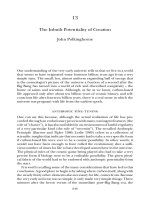050 the release stage of plosives
Bạn đang xem bản rút gọn của tài liệu. Xem và tải ngay bản đầy đủ của tài liệu tại đây (111.88 KB, 3 trang )
1
Prof. Francisco Zabala - 2016
The Release Stage of Plosives:
The literature is clear with regard to the complex nature of plosive sounds. Although some writers
(Cruttenden: 2014) postulate that there are three stages in the production of a plosive sound, we will
follow a more thorough analysis (Arnold: 1971; Wells & Colson: 1971; Roach: 2009) that adds a fourth
stage (something implicit in Cruttenden, though).
Plosive sounds are made up of three stages:
1. The CLOSING STAGE: the articulators come together to produce a complete oral closure that
prevents the airflow from escaping (since plosive sounds are oral sounds, it is understood that the
velum is raised so that the airflow does not escape through the nose, either).
2. The COMPRESSION STAGE: the air coming from the lungs is built up behind the oral closure. This
raises the pressure inside the oral chamber.
3. The RELEASE STAGE: the articulators separate abruptly, thus removing the blockage.
4. PLOSION: the auditory effect produced by the noise that the compressed air makes as it escapes.
Learners should be aware of the fact that some or several of these stages may not always be present due
to contextual reasons. The aim of the following section is to help you distinguish between COMPLETE
PLOSIVE sounds that are exploded (i.e. you can hear their plosion) from MASKED PLOSIVES (i.e. you cannot
hear either the release or the plosion).
1. COMPLETE ORAL RELEASE AND PLOSION: the articulators separate abruptly and the air escapes freely
through the mouth producing its characteristic explosive noise. This is typical when a vowel sound
follows a plosive. It may also be possible before silence or, in extremely careful or declamatory
speech, in a sequence of a plosive sound followed by another plosive, a lateral or a nasal. Although
there is no diacritical mark for this, the latter case may be indicated by the use of aspiration or
affrication when suitable:
Baboon
Za?!at9m\
Daddy Z!czch\
Told me
Z!s?Tkc'y(
lh\
Bag Z!azf
{{\
'g(
That person Z!Czs
!o29rm\
Z!Czs'r(
!o29rm\
2. MASKED PLOSIVES: The plosive is felt to be “incomplete” because it lacks its characteristic explosive
noise. Learners should aim at mastering this feature, since it is only in over-careful or declamatory
speech that plosives are always exploded. By the same token, failing to mask plosives can both
hinder learners’ fluency as well as distract their listeners’ attention.
a. PLOSIVE + NASAL: there is true nasal release when a plosive is followed by a homorganic
nasal. The oral closure is kept, so the contact made between the articulators should not be
removed. Consequently, the air escapes through the nose when the soft palate is lowered
and the nasal cavity is opened. The Spanish tendency to insert an intrusive vowel should be
repressed: ‘not now’ *Z!mPs?
!m`T\. (For teaching purposes, some writers extend label to
any sequence of a plosive followed by a heterorganic nasal sound in order to remind the
student that no intrusive vowel should be heard. The oral closure required by the nasal
sound anticipates the release of the plosive, so no oral plosion should be heard. C.f. NO
PLOSION.)
At night
Bad news
Ribbon
Organ
Z?s^
!m`Hs\
Z!azc^
!mit9y\
Z!qHa^m\
Z!N9f^m\
Button
Sudden
Happen
Bacon
Z!aUs^m\
Z!rUc^m\
Z!gzo^m\
Z!adHj^m\
2
Prof. Francisco Zabala - 2016
b. LATERAL RELEASE: there is true lateral release when a plosive is followed by a homorganic
lateral sound. This occurs only in the sequences .sk+
ck. as the tongue tip contact made
against the alveolar ridge is not removed, so the plosive is released by the lowering of one
or both sides of the tongue. The important point that the foreign learner should bear in
mind is that no vowel is to be heard. Spanish speakers should, for instance, try to avoid
pronunciations such as ‘not light’ *Z!mPs?
!k`Hs\). (Since what is sought is the omission of an
intrusive vowel in these cases, the concept of lateral release is also extended by some
writers to sequences of heterorganic plosive and lateral sounds. The alveolar closure
required by the lateral anticipates the release of the plosive, so no oral plosion should be
heard. C.f. NO PLOSION.)
Bottle
Subtly
At last
Big lake
Z!aPs^k\
Z!rUs^kh\
Z?s^
!k@9rs\
Z!aHf^
!kdHj\
Middle
Mildly
Bad luck
Bubble
Z!lHc^k\
Z!l`Hkc^kh\
Z!azc^
!kUj\
Z!aUa^k\
c. NO RELEASE & GEMINATION: when a plosive is followed by a homorganic plosive or affricate,
its third and fourth stages will not take place. The second stop consonant, at the same
time, will lack its closing stage, due to the pre-existing homorganic closure made for the
plosive. To put it simply, the stop cluster is made up of (1) a closing stage; (2) a
compression stage that is twice as long since it comprises the first plosive’s compression
stage and the second stop consonant’s compression stage; (3) and a release stage (and
plosion, if suitable) for the second consonant. Learners should be careful not to think that
the plosive disappears altogether: its presence is manifested by means of the extra length
of the compression stage. The diacritical mark used for this type of release is the same that
is used for non-audible release, since the auditory effect is similar (i.e. no plosion is heard).
If the two plosives are geminates (that is, both are exactly the same sound) the cluster is
perceived as just one long plosive sound. Again, the Spanish tendency to insert an intrusive
vowel should be avoided: e.g. ‘bad day’ *Z$azc?
!cdH\.
Bad dog
Big girl
Black cat
Z!azc^
!cPf\
Z!aHf^
!f29k\
Z!akzj^
!jzs\
Pete died
Z!oh9s^
!c`Hc\
Jack Gray
Z!cYzj^
!fqdH\
David chokes Z!cdHuHc^
!sR?Tjr\
d. NO PLOSION & NO AUDIBLE RELEASE: the third and fourth stages will not normally be heard
when a plosive is followed by a heterorganic plosive, affricate, lateral or nasal. The closing
stage of the forthcoming stop consonant, or the lateral or nasal approach, is finished
before the first plosive is released. Therefore, when the first plosive is finally released
there is no plosion. This is also possible before silence in colloquial speech. The diacritical
mark used for this type of release is the same that is used for no release, since the auditory
effect is similar (i.e. no plosion is heard). What the learner should be careful about is not to
produce an intrusive vowel in these sequences: ‘act’*Zzj?s\.
It can
Bob jumps
Bad men
ZHs^
!jzm\
Z!aPa^
!cYUlor\
Z!azc^
!ldm\
Rubbed
Great!
Happen
Z!qUa^c\
Z!fqdHs^\
Z!gzo^m\
Prof. Francisco Zabala - 2016
3
Activity 1:
Focus on the plosive sounds in the following sentences and transcribe them phonemically. Then, use [ ^ ]
to show that the plosives are not exploded (i.e. masked) when they are followed by another plosive, an
affricate, a nasal or .k..
1. Ted Darcy went to the Great Lakes in Scotland.
2. Not now, my little boy. I need to write to your grandparents.
3. What time did Daisy call?
4. Rob Nelson put many people in trouble.
5. That gate doesn’t face the front door.
6. Did Chester like my grand tour?
7. That taut rope cannot cope with all that tension.
8. Greg Gibson said many bad things about Luke Gardner.
9. That gig Peter invited me to was great, girls!
10. David Pollard bought two little bottles of beer and a carton of apple juice.
KEY:
1.
2.
3.
4.
5.
6.
7.
8.
9.
10.
Z!sdc^
!c@9rh
{
!vdms^
s?
C?
!fqdHs^
!kdHjr
Hm
!rjPs^k?mc\
Z!mPs^
!m`T
l`H
!kHs^k
!aNH
{{
`H
!mh9c^
s?
!q`Hs^
s?
iN9
!fqzmc^od?q?msr\
Z!vPs^
!s`Hl
cHc^
!cdHyh
!jN9k\
Z!qPa^
!mdkr?m
!oTs^
!ldmh
!oh9o^k
Hm
!sqUa^k\
ZCzs^
!fdHs^
!cUyms
!edHr
C?
!eqUms^
!cN9\
ZcHc^
!sRdrs?
!k`Hj^
l`H
!fqzmc^
!sT?\
ZCzs^
!sN9s
!q?To
!jzmPs^
!j?To
vHC
N9k
Czs^
!sdmRm\
Z!fqdf^
!fHar?m
{
rdc^
!ldmh
!azc
!SHMy
{
?!a`Ts^
!kt9j^
!f@9c^m?\
ZCzs^
!fHf^
!oh9s?
Hm!u`HsHc^
lh
st9
v?y
!fqdHs^
!f29ky\
Z!cdHuHc^
!oPk?c^
!aN9s^
!st9
!kHs^k
!aPsk^y
?u
!aH?
{
?m
?
!j@9s^m
?u
!zo^k
!cYt9r\
Activity 2:
Focus on the plosive sounds in the following text and transcribe them phonemically. Then, use [ ^ ] to
show that the plosives are not exploded (i.e. masked) when they are followed by another plosive, an
affricate, a nasal or .k..
Gossip Girl
Janet Park is not a bad person, but people don’t like her because she can’t keep her mouth
shut. If you tell a secret to her, she won’t be able to keep it to herself. I think Ms. Park battles
against her nosy nature, but it destroys her heart not to rush out to let ladies know about a
new juicy piece of good gossip. Now, if you do want people to learn about something, be it true
or not true, you just give her a quick call, and the rumour is out. You can spread terrible
rumours about someone without damaging your own name.
Z!fPrHo^
!f29k
{{
!cYzm?s^
!o@9j
{
Hy
!mPs
?
!azc^
!o29rm
{
a?s^
!oh9o^k
!c?Tms^
!k`Hj
g?
{
aH!jPy
Rh
!j@9ms^
!jh9o
g?
!l`TS
!RUs
{{
He
it
!sdk
?
!rh9jq?s^
!st9
g?
{
Rh
!v?Tms^
ah
!dHa^k
s?
!jh9o
Hs^
s?
g?!rdke
{{
`H
!SHMj^
!lHr
!o@9j^
{
!azs^ky
?!fdmrs
g?
!m?Tyh
!mdHsR?
{
a?s
Hs^
cH!rsqNHy
g?
!g@9s^
{
!mPs^
s?
!qUR
!`Ts^
s?
!kds^
!kdHchy
!m?T
{
?!a`Ts
?
!mit9
!cYt9rh
!oh9r
{
?u
!fTc^
!fPrHo^
{{
!m`T
{
He
it
!ct9
!vPms^
!oh9o^k
s?
!k29m
?!a`Ts
!rUlSHM
{
ah
Hs^
!sqt9
N9
!mPs^
!sqt9
{
it
cY?rs^
!fHu
g?q
?
!jvHj^
!jN9k
{
?m
C?
!qt9l?q
Hy
!`Ts^
{{
it
j?m
!roqdc^
!sdq?a^k
!qt9l?y
?!a`Ts
!rUlvUm
{
vH!C`Ts^
!czlHcYHM
iN9q
!?Tm
!mdHl\









